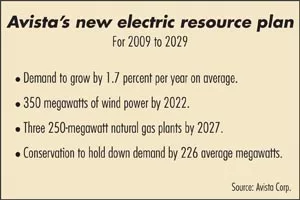Avista plans to add much wind power
Company says such plants will supply 350 megawatts of capacity within 13 years

Avista Utilities plans to build or acquire 150 megawatts of wind-powered generation by 2012 to take advantage of renewable-energy tax incentives, to diversify its resource mix, and to meet renewable-energy requirements.
The Spokane company lays out that goal in its 2009 Electric Integrated Resource Plan, which it filed on Monday. The document, updated every two years, spells out how the company expects its system will grow in the next 20 years—and how it will meet the added demand for electricity that the growth will bring.
In addition, the company projects that it will develop three 250-megawatt natural-gas-fired electrical generation plants, in 2019, 2024, and 2027. That would make it much more of a thermal-powered utility than it has been in the past. While it has 786 megawatts of thermal-powered generation now, 222 megawatts of that is coal-fired generation at Colstrip, Mont., and 50 megawatts of it is wood-waste-fired generation at its Kettle Falls, Wash., wood-fired plant.
"Avista does not plan to add any coal-fired generation to its resource mix," the plan's introduction says, reiterating a conclusion in the company's 2007 integrated resource plan.
The company says it anticipates adding 150,000 retail customers by 2029, with demand for electricity growing by an average of 1.7 percent annually during that period. Avista provides electrical service to 353,000 homes and businesses and provides natural gas to 313,000 homes and businesses now, serving more than 492,000 customers in all.
President Dennis Vermillion says the new plan ensures that Avista will remain among the nation's greenest utilities.
Avista already is planning to build its first wind-powered plant, a 50-megawatt development near Reardan, Wash., soon, and says in its new plan that it will build or acquire an additional 100 megawatts of wind-powered generation within the next three years to take advantage of tax incentives and to meet other goals. A megawatt of power is enough to serve 750 homes on Avista's system.
Moreover, Avista says it will develop or acquire an additional 200 megawatts of wind-powered generation by 2022, which would make it a much different utility than the longtime Spokane concern that developed a portfolio of hydropower projects and relied on it for much of the 20th century.
"We're talking about 350 megawatts of wind" power in all, says company spokesman Hugh Imhof. "We wouldn't necessarily build all that. We would obtain some of that, maybe," from wind-generation plants built by others.
Even though the company projects that demand for electricity will grow by an average of 1.7 percent, it says it expects to hold down demand by 226 average megawatts during the life of the plan through "aggressive" energy-efficiency measures, which would enable it to cut its generation requirements by 26 percent, or 339 megawatts of generating capacity, Imhof says.
It says transmission upgrades will be needed to integrate new generation into its system during those 20 years.
The company also plans to make five megawatts of hydropower upgrades at its Little Falls and Upper Falls projects, and it will study large hydropower upgrades as potential new renewable resources for its 2011 integrated resource plan.
Avista says the electric IRP was developed with the help of a technical advisory committee made up of customers, utility commission staff members, government agencies, and Avista's own energy analysts.
It says the Washington Utilities and Transportation Commission and the Idaho Public Utilities Commission will review the document and provide opportunities for public comment. Avista plans to file an integrated resource plan for the natural-gas side of its business in December.
Related Articles

_c.webp?t=1763626051)
_web.webp?t=1764835652)

